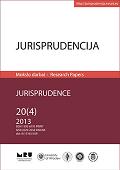Der Europäische Minderheitenbegriff Entwicklung und Wirkung. Teil 1
Der Europäische Minderheitenbegriff Entwicklung und Wirkung. Teil 1
Author(s): Arndt KünneckeSubject(s): Law, Constitution, Jurisprudence
Published by: Mykolas Romeris University
Keywords: International Law; Human Rights; Minority rights; concept of minority; European Union
Summary/Abstract: In Europe, more than 330 ethnic groups with altogether more than 100 million members exist. Almost all European countries host minorities on their national territory. But until now, the term “minority” has not been clearly and unambiguously defined in international law. However, there is mutual consent that a single state is not entitled to decide upon the existence of minorities on its national territory on its own. Otherwise, the state could simply deny the existence of a minority and withdraw itself from all internationally binding legal obligations in that area. Therefore, since the times of World War I, various efforts have been made to define the term “minority”. In international law, a universally recognized and binding concept of minorities does not exist. However, in order to determine which minorities are supposed to be protected, after World War II some regularly applied characteristics have been developed in international documents. Even without giving a clear definition of the term “minority”, documents of the UN, the UNESCO or the CSCE/OSCE provide a special protection of different kinds of minorities, such as ethnic, national, religious and linguistic minorities. First and foremost, they are protected by the Universal Declaration on Human Rights (UDHR) of 1948, the International Covenant on Civil and Political Rights (ICCPR) of 1966, the Convention on the Rights of the Child (CRC) of 1989, the Declaration on the Rights of Persons belonging to National or Ethnic, Religious and Linguistic Minorities (UN Minorities Declaration) of 1992, various declarations by the UNESCO as well as several documents by the CSCE and later OSCE. However, the only international document within the frame of the UN, the UNESCO and the CSCE/OSCE, offering a (non-binding) definition of the term “minority”, is a UN study conducted by Special Rapporteur of the United Nations Sub-Commission on Prevention of Discrimination and Protection of Minorities, Francesco Capotorti. According to that study, which was published in 1979, the term “minority” denotes a group numerically inferior to the rest of a state’s population, in a non-dominant position, whose members are nationals of the state of residence and possess ethnic, religious or linguistic characteristics differing from the rest of the population and showing a certain sense of solidarity towards the group itself. In the second part of the essay, it will be shown that the European states took these documents as basis to create their own concept of minorities, which can be deduced from documents of the Council of Europe and the EC/EU.
Journal: Jurisprudencija
- Issue Year: 20/2013
- Issue No: 4
- Page Range: 1283–1301
- Page Count: 19
- Language: German

